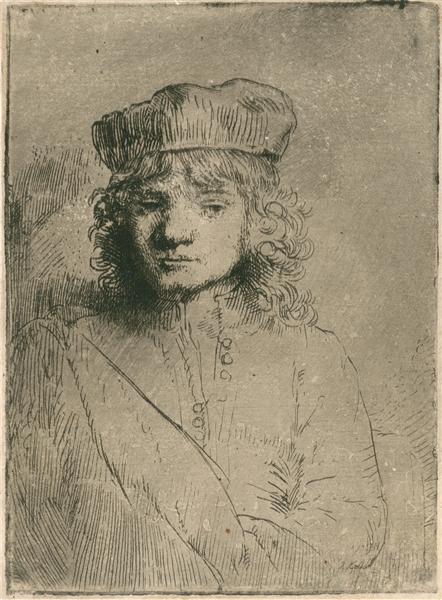Descriere
Rembrandt's The Artist's Son Titus, painted in 1656, is a moving testament not only to the Dutch master's technical skill but also to his deep emotional connection to family. In this painting, Rembrandt portrays his son Titus, who becomes the central focus of the composition. The work is a magnificent example of the use of chiaroscuro, a technique that Rembrandt masterfully embraced throughout his career, creating an atmosphere of intimacy and reflection that invites the viewer into deeper contemplation.
Looking at the painting, one perceives the richness of the color, which varies from the dark tones of the background that frame the main character, to the warmer, golden hues that highlight Titus' skin. The soft lighting on his face reveals a pensive, almost melancholic expression, which could be interpreted as a reflection on life and mortality. Rembrandt manages to capture an introspective essence in his son, which is both an individual portrait and an emblematic symbol of the continuation of his artistic legacy.
The imposition of the figure on the canvas is powerful, as Titus, dressed in a shirt of a soft light shade that contrasts with the dark background, not only occupies the physical space, but also fills the emotional aura of the work. There is a notable lack of embellishments or distracting elements in the composition, allowing the viewer's attention to be completely focused on the young man. This stylistic decision reflects the personal and almost autobiographical approach that Rembrandt applies to his portraits, revealing not only the appearance, but also the personality and emotional state of the subject.
Furthermore, the use of minute detail in the depiction of Titus's hands and face highlights Rembrandt's technical mastery in the treatment of light and shadow. The young man's delicately modelled hands create a sense of fragility and vulnerability, accentuating the intimacy of the moment. Titus's gaze, directed towards an indefinite point beyond the viewer, suggests a connection between the present world and the contemplative universe that is embedded in the symbolism of the painting.
Although there is little documentary evidence of the painting itself, Rembrandt's deep relationship with his son is well-known, as he was both a source of joy and suffering. Titus died young, adding a layer of nostalgia to this depiction. This rich biographical context reinforces the interpretation of the painting as a precious memory of a parental relationship filled with love and pain.
“The Artist’s Son Titus” aligns with Rembrandt’s other family portraits, combining his ability to capture the physical essence of his subjects with deeper evocations of their character and existence. Through this work, one can observe not only the evolution of his artistic style towards more personal and emotional moments, but also the reflection of the struggles and triumphs of his family life. In this sense, the painting stands as a powerful visual narrative that transcends time, reaching out to resonate with the universal experiences of fatherhood and loss. Rembrandt’s ability to weave these emotional threads into his work is what continues to fascinate and inspire art lovers to this day.
KUADROS ©, a famous painting on your wall.
Hand-made oil painting reproductions, with the quality of professional artists and the distinctive seal of KUADROS ©.
Painting reproduction service with satisfaction guarantee. If you are not completely satisfied with the replica of your painting, we will refund 100% of your money.

